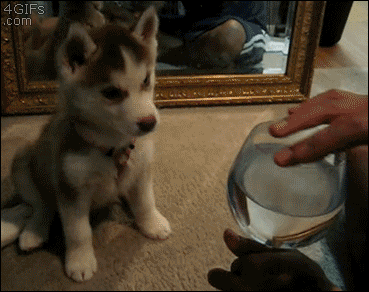Teaching Your Puppy to Lie Down
 What it means:
What it means:
Lie down, right here, right away.
- Verbal Command: “Down”
- Tone of voice: Downward tone, somewhat commanding
- Hand Signal: Right hand palm down, moving in a downward motion
How to:
Start with your puppy in a sit at your left side. Bend over or kneel down next to the puppy. With your left hand reach over the top of your puppy and grasp his left front leg, and with your right hand grasp his right front leg. Then gently pull his front feet out from under him.
If he resists, use your left hand (or for large puppies – left forearm) to exert pressure on his shoulders. The instant that he begins to lie down, release the pressure on his shoulders and let go of his feet. If your puppy breaks out of the “sit,” put him back into a sitting position and continue placing him in the “down.”
Do’s and Don’ts:
Everything for the “down” command goes down, your voice, the leash correction, the puppy. As long as the puppy is in the “down” position, the leash should be down. Do not inadvertently pull up on the leash, or put any pressure on the leash while the puppy is in the “down” position.
If your puppy is lying down behind or in back of you, he may be feeling intimidated by the command. Just slide him back into position next to you, and try not to loom. Be patient, maintain a sense of humor, do not lose your temper, but persist until the puppy has obeyed.
As soon as the puppy is lying down, stand up and be casual, as if you knew all along that he would comply with the command. Do not loom or lean over the puppy. Avoid using a dominant posture to coerce your puppy into staying “down.” You want your puppy to stay in position because he decided to, not because he sees that you are watching. Avoid eye contact, and don’t pet the puppy until after he has been released from the “down” command.
Don’t push down on your puppy’s back, or smash down hard on his shoulders. Gentle pressure on the shoulders along with pulling the feet out from under the puppy will usually suffice.
Problem solving:
If your puppy bites at your hands a lot, use the leash to control your puppy’s head while using your left hand to put pressure on the shoulders. Don’t hover over a biting puppy, this will escalate the problem. Pop the puppy into the down position quickly and with authority, then stand up straight. This is not the time to address the biting issue. Avoid and ignore it while teaching down. Your puppy won’t be able to bite you if he is in a down at your side and you are standing up.
If the puppy is very resistant and naughty with the biting, put your left foot on the leash, close to the collar and pin the puppy’s neck to the floor with your foot. The instant your puppy relaxes and gives in, take your foot off the leash. Do not hover over a biting puppy, this will escalate the problem.
If your puppy starts chewing on your shoe laces, or the leash, or your pant leg, give the “stay” command and step farther away. If this brings the puppy out of the down, that’s OK. Just put the puppy back into position.
Very Young Puppies:
If your puppy is very young, (6 to 8 weeks) you can sit down (on the floor) with your puppy, and place the puppy in front of you facing sideways. This makes it easier to put the puppy into a down, and discourages leaning on you. As soon as the puppy is placed, let go and move back, staying ready to grab the leash if the puppy tries to bolt.
What your puppy learns:
This command requires your puppy to assume a submissive position. Many puppies will offer some resistance when learning this command. The higher the resistance, the more important it is that you assert your position of leadership in the other areas of your puppy’s life.
Down for a treat:
Start with your puppy in a sit. Hold the treat in your right hand close to your puppy’s nose. Then, take the treat down to his toes. Nose to toes is how it should go. This requires the puppy to go almost into a down in order to get the treat. Some puppies will lay down spontaneously, most puppies will need a bit of help in the form of a small amount of pressure on the shoulders. The instant that the puppy lies down, give the treat. When using food it is important to keep the treat close to the puppy’s nose to discourage jumping up, and then take it directly down to the puppy’s toes. If you move the treat forward as you take it down, the puppy will move forward to get the treat instead of lying down. If your puppy backs up, or gets up out of the sit, place the puppy back into a sitting position and repeat the down command and the downward motion with the treat
Do’s and don’ts with treats:
Do not allow the puppy to grab for and get the treat. Because you will be practicing and doing this more than once, use a really small treat, something that smells good and is easy to eat. Don’t worry about teaching the stay command when using a treat for the “down.” That can come later, after the puppy knows and understands how to lie down for a treat. Give the treat to the puppy as soon as he is in the down. Don’t wait for him to get up or move around.
Written by: Shirley Gibson
Note:
You are welcome to share this post but ONLY IF you give credit and a link back to Teach Your Dog To Behave or shirleytwofeathers.com.
- Dog Training School Pics by shirleytwofeathers - 1 Comment
- Some Cute Dog Quotes by shirleytwofeathers - No Comment
- Training Do’s and Don’ts by shirleytwofeathers - No Comment
- Holiday Toxins and Dangers by shirleytwofeathers - No Comment
- Four Good Reasons To Train Your Dog by shirleytwofeathers - No Comment
John kleist: Dog Training School Pics



Leave a Reply